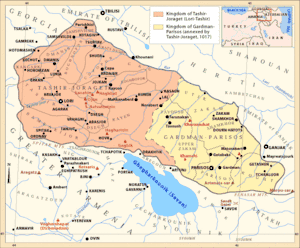Kingdom of Tashir-Dzoraget
| Kingdom of Tashir-Dzoraget Տաշիր-Ձորագետի Թագավորություն | |||||||||
|---|---|---|---|---|---|---|---|---|---|
| 979–1118 | |||||||||
 Kingdom of Tashir-Dzoraget c. 1017 A.D. | |||||||||
| Capital |
Matsnaberd (979-1065) Lori (1065-1118) | ||||||||
| Common languages | Armenian | ||||||||
| Religion | Armenian Apostolic Church | ||||||||
| Government | Monarchy | ||||||||
• 979–989 | Kiurike I | ||||||||
• 1089–1118 | David II of Lori | ||||||||
| Historical era | Middle Ages | ||||||||
• Established | 979 | ||||||||
• Kiurike I becomes the first ruler. | 979 | ||||||||
• Disestablished | 1118 | ||||||||
| |||||||||
Kingdom of Tashir-Dzoraget (Armenian: Տաշիր-Ձորագետի Թագավորություն Tashir-Dzorageti t'agavorut'yun), alternatively known as the Kingdom of Lori or Kiurikian Kingdom, was a medieval Armenian kingdom formed in the year 979 by the Kiurikian dynasty under the protectorate of the Bagratid kings of Armenia. The capital of the kingdom was Matsnaberd, currently part of modern-day Azerbaijan.
It was located on the territories of modern-day northern Armenia, northwestern Azerbaijan and southern Georgia. The founder of the kingdom and the Kiurikian dynasty was king Kiurike I (also known as Gurgen I).[1]
In 979 King Smbat II of Armenia granted the province of Tashir to his brother Kiurike with the title of king.[2] The branch went on to outlive the main one in Ani.
It became especially strong during the reign of King David I Anhoghin who succeeded his father Kiurike and ruled between 989 and 1048. David I Anhoghin conquered some territories from Emirates of Tbilisi and Ganja, and chose Samshvilde as his residence. Later on, he tried to gain independence from the Bagratid kings of Ani. However, after failing he was punished by King Gagik I. His properties were confiscated to become known as "Anhoghin" meaning "the Landless." David I was succeeded by Kiurike II who ruled between 1048 and 1089). After the fall of the Bagratid Kingdom of Armenia, Kiurike II was bestowed by the Byzantines with the title of Kouropalates.
Kiurike II moved the capital from Matsnaberd to Lori in 1065.
In 1089, David II succeeded his father Kiurike II until 1118 when Tashir-Dzoraget was annexed to the Kingdom of Georgia.
Unlike their Bagratuni relatives, the Kiurikian kings were unique in minting their own coins, with the line, "May the Lord aid Kiurike (George) the Khorapaghat (Kouropalates)," running in five lines inscribed on the reverse side.[3] They sponsored the construction of a number of churches and monasteries in northern Armenia, including those in Sanahin, Haghpat and Haghartsin,[4] where a great many of them were interred.[5]
Gallery
.jpg)
- Akhtala fortress, built by the Kiurinians at the end of the 10th century
- Lori, the 2nd capital of the kingdom
References
- ↑ (in Armenian) Matevosyan, Raphael I. (1976). "Տաշիր-Ձորագետը և Հայաստանի Հյուսիս-Արևմտյան Գավառները IX-XI Դարերում," [Tashir-Dzoraget and the north-western regions of Armenia in the ninth to eleventh centuries] in Հայ Ժողովրդի Պատմություն [History of the Armenian People], eds. Tsatur Aghayan et al. Yerevan: Armenian Academy of Sciences, vol. 3, pp. 100-05.
- ↑ (in French) Movsesian, Łevond. "Histoire des rois Kurikian de Lori," trans. Frédéric Macler, Revue des Études Arméniennes 7, Pt. 2 (1927), 209ff.
- ↑ See Philip Grierson, "Kiurike I or Kiurike II of Loṛi-Armenia?: A Note on Attributions," American Numismatic Society Museum Notes 10 (1958), pp. 107–12.
- ↑ Ovannes Ghalpakhtchian and Adriano Alpago-Novello (1970), Sanahin, Milan: Ares.
- ↑ Manuk-Khaloyan, Armen, "In the Cemetery of their Ancestors: The Royal Burial Tombs of the Bagratuni Kings of Greater Armenia (890-1073/79)," Revue des Études Arméniennes 35 (2013), p. 168, note 124.

